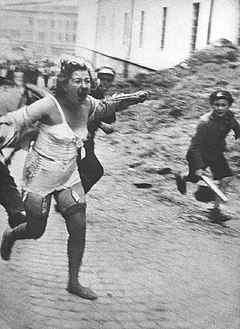
Back مذابح لفيف (1941) Arabic Lvov poqromu (1941) Azerbaijani Львоўскі пагром (1941) Byelorussian Pogromy ve Lvově Czech Πογκρόμ του Λβιβ (1941) Greek Pogromoj de judoj en Lvovo Esperanto Pogromos de Leópolis (1941) Spanish پوگرومهای لووف (۱۹۴۱) Persian Pogroms de Lviv de 1941 French הפוגרומים בלבוב HE
 A Jewish woman chased by men and youth during the pogrom | |
| Date | June 1941 – July 1941 |
|---|---|
| Location | Lviv, Eastern Poland/Western Ukraine |
| Coordinates | 49°30′36″N 24°00′36″E / 49.510°N 24.010°E |
| Type | Beatings, sexual abuse, robberies, mass murder |
| Participants | Germans, Ukrainian nationalists, local crowds |
| Deaths | Thousands of Jews (see estimates) |
The Lviv pogroms were the consecutive pogroms and massacres of Jews in June and July 1941 in the city of Lwów in German-occupied Eastern Poland/Western Ukraine (now Lviv, Ukraine). The massacres were perpetrated by Ukrainian nationalists (specifically, the OUN), German death squads (Einsatzgruppen), and urban population from 30 June to 2 July, and from 25 to 29 July, during the German invasion of the Soviet Union. Thousands of Jews were killed both in the pogroms and in the Einsatzgruppen killings.
Ukrainian militia as well as Ukrainian residents and to a lower degree Poles targeted Jews in the first pogrom,[1][2] which was triggered by the discovery of thousands of bodies in three Lviv prisons of victims of the Soviet NKVD prisoner massacres, which were widely blamed on "Jewish Bolsheviks". The subsequent massacres were directed by the Germans in the context of the Holocaust in Eastern Europe. The pogroms have been widely debated in the historiography, including the extent to which Ukrainian nationalists played a central or complicit role.[3][4]
- ^ Kopstein 2020, pp. 219–220: Kopstein writes: "On June 30, 1941, on the eighth day of operation Barbarossa, the German invasion of the Soviet Union, a pogrom broke out in Lviv, the capital city of Eastern Galicia. Ukrainians, and to a lesser extent Poles, massacred their Jewish neighbors and fellow citizens. ... For the next two days Lviv witnessed terrible anti-Jewish violence at the hands of the local Ukrainian population and the Ukrainian militia, and under the Nazis' approving eyes.".
- ^ Glöckner Olaf (2021). "The Collaboration of Ukrainian Nationalists with Nazi Germany". In Bitunjac, Martina; Schoeps, Julius H. (eds.). Complicated Complicity European Collaboration with Nazi Germany During World War II. De Gruyter. pp. 90–91. ISBN 9783110671261.
Ukrainian militiamen and civilians chased down Jews, took them to the prisons, forced them to exhume bodies of killed prisoners, mistreated and finally killed them.
- ^ Kopstein 2020, pp. 215–228.
- ^ Kiebuzinski & Motyl 2017, pp. 56–65.